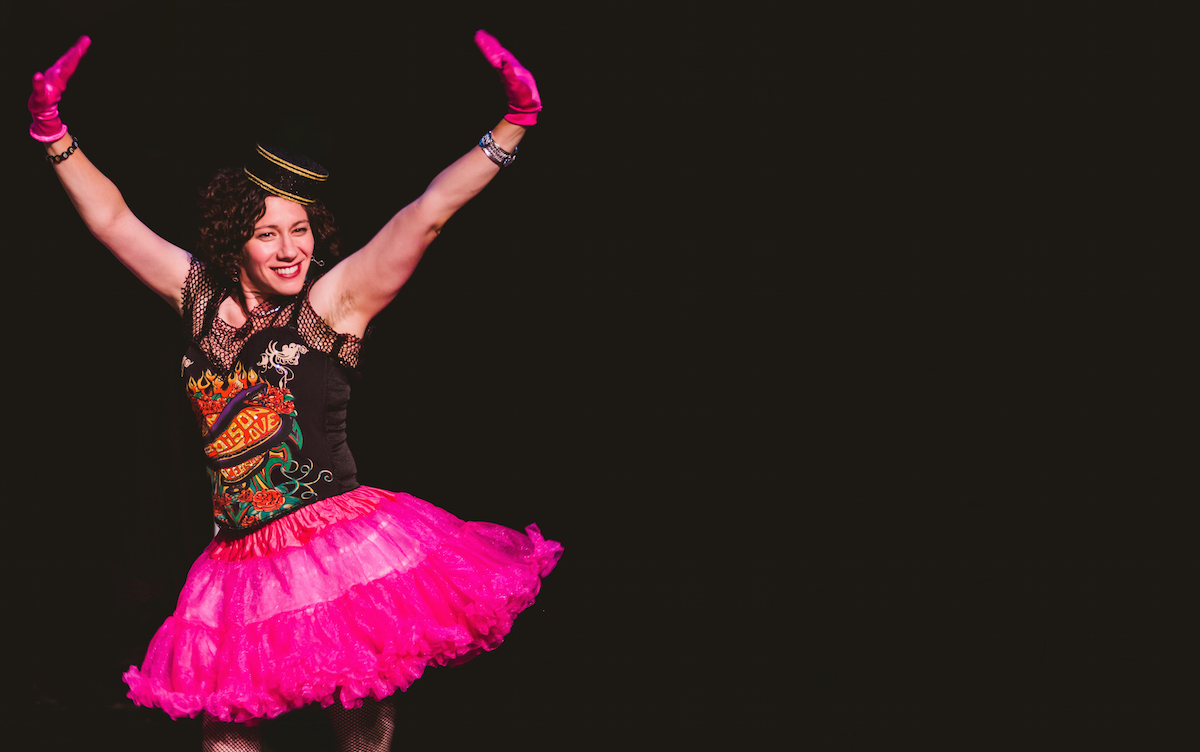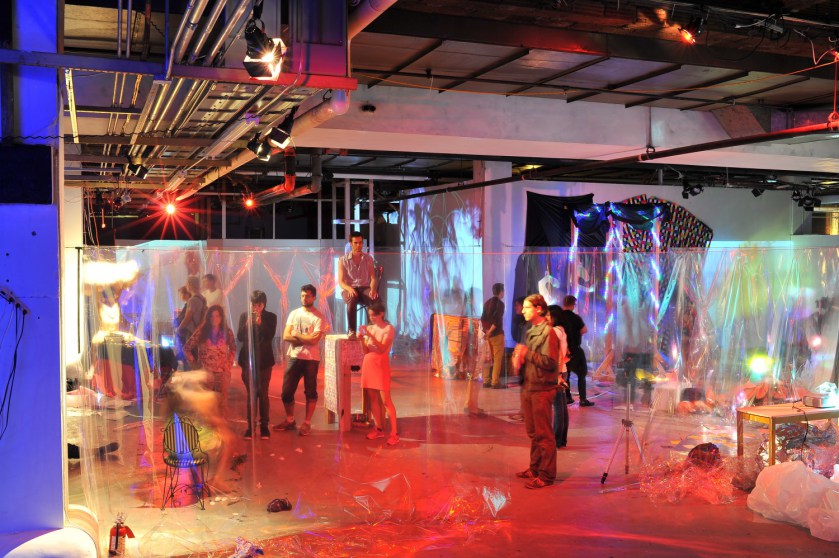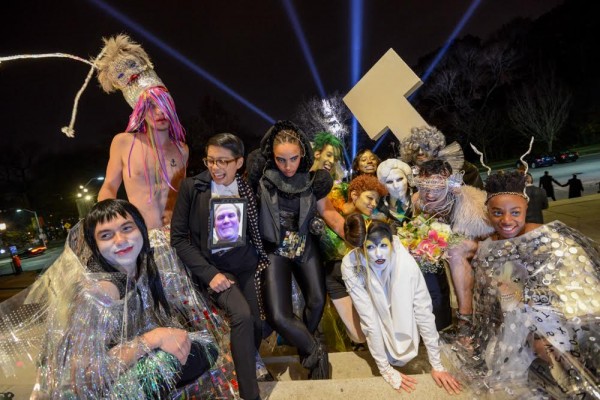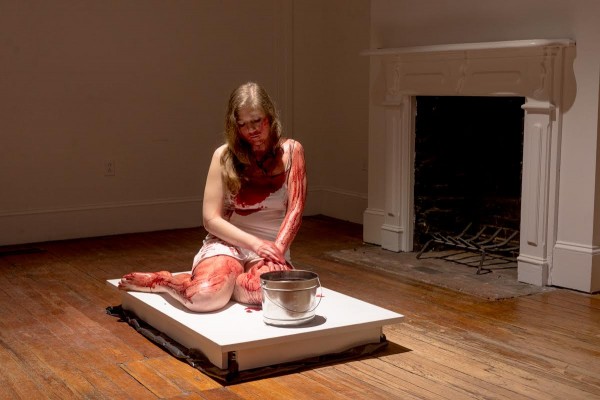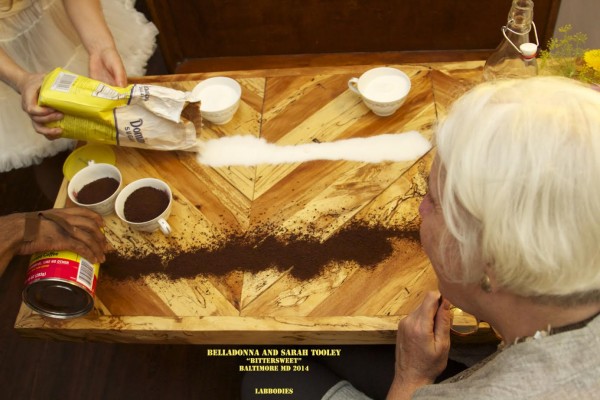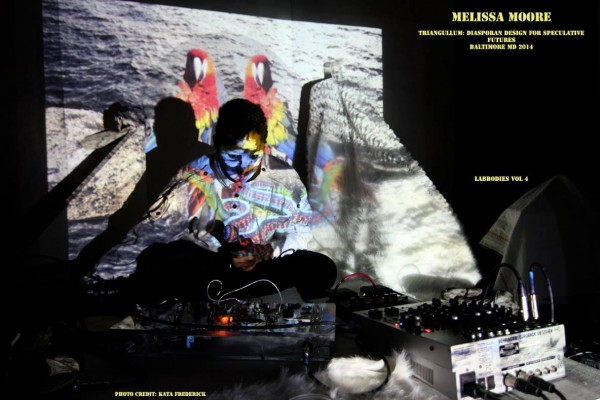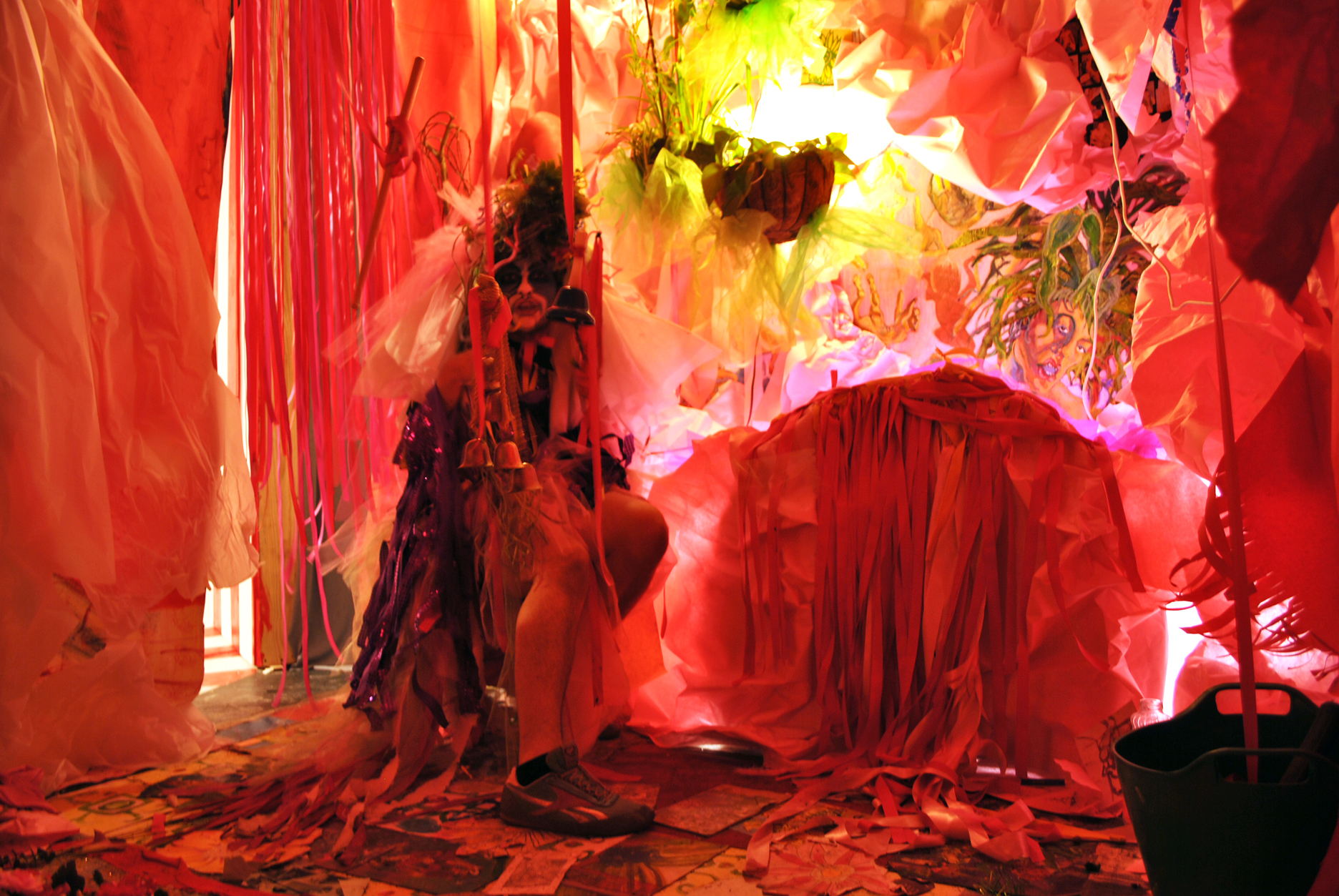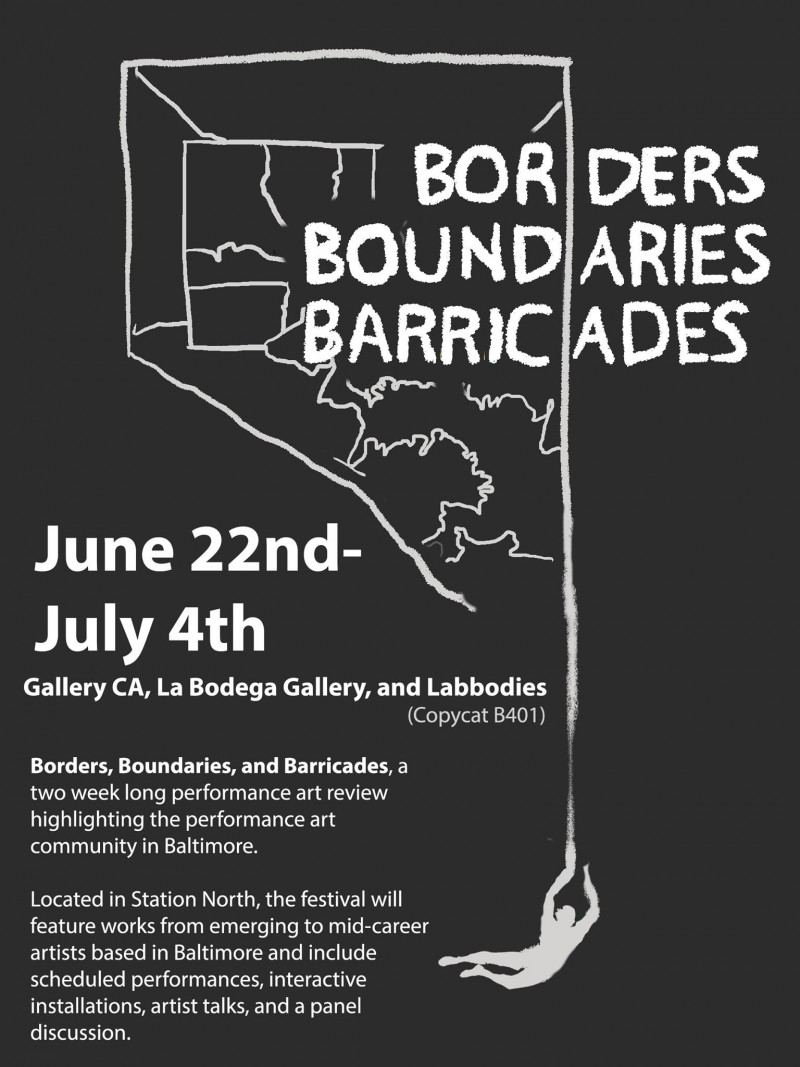A Q&A with Labbodies in Advance of Borders, Boundaries, and Barricades by Rebecca Juliette
From June 22-July 4th, Baltimore plays host to a Borders, Boundaries, and Barricades – a performance art festival organized by Labbodies. Over the course of two weeks, 30+ artists will examine how “boundaries” are defined and how we relate to them. Bmore Art had a chance to virtually sit down with the founding members of Labbodies, Hoesy Corona (HC) and Ada Pinkston (AP), to find out more about the festival and their organization. Here’s what we learned:
BmoreArt: Tell me a little more about Labbodies. When and how did the organization form?
HC: Labbodies, is a performance art laboratory founded in January 2014 by Multidisciplinary Artists, Curators and current Co-Directors Dr. A. Pinkston and Dr. H. Corona. Kristin Mcwharter joined our team in 2015 and is the current program manager for our Lab Nights as well as The Borders, Boundaries and Barricades Review. The idea for the lab came about after attending The Contemporary’s inaugural Co-Host lecture by renowned performance artist Coco Fusco and a subsequent conversation that followed about the state of performance art in Baltimore. We set out to find out if there was a need for a performance art platform to highlight and exhibit the work of contemporary performance artists in the city and to identify an audience.
AP: We started LabBodies after a long conversation that we had after the Coco Fusco lecture sponsored by the Contemporary. One of the things that we noticed was that a lot of the audience shied away from any dialog about the performative elements of her lecture. This silence in Coco Fuscos post lecture QandA was a huge representation of the silence we felt around any discourse of performance art in our community. The foundation of Labbodies was formed from the working relationship we developed from Rooms Fall Apart that debuted in Transmodern in 2013. Fast forward to January 2014 which was when our inaugural Lab Night took place.
From that date, we have been curating and developing platforms to highlight performance art ever since. Experimentation, collaboration, and audience interaction are three of the guiding principles of LabBodies performance art lab. Hoesy and I are both the co-founders/organizers/curators. LabBodies for us is part performative experiment (as the Doctors) and part start up arts organization. Currently, we are in the process of developing a framework to represent performance artists.
BmoreArt: Can you discuss some of the previous events that Labbodies sponsored?
HC: Most notably we were approached by a trustee of The Baltimore Museum of Art in the fall of 2014 and commissioned by the museum to curate “Fast Forward Future,” a series of performance art works that envisioned the museum of the future for their centennial celebration. In 2014, we were also commissioned by The Transmodern Festival to curate “Over Under Limbo” – a two night international performance art happening that brought together over 20 performance artists. And in the spring of 2014, “The Flower Shop” was commissioned by The Bromo Arts and Entertainment District’s “Bromo Block Hop” to activate an empty store front that used to be a florist shop on Howard St. at the turn of the last century.
AP: Our one year anniversary was held at the Copycat (B401) during AllOverStreet. Recently, we partnered with Platform Gallery to host Emilia’ Pennanen’s Blood Cube. We loved working with the folks at Platform, look out for more collaborations with them soon. Platform was also the venue for a soft launch of “Performance Art Pay Per View”. A project that we are currently in the process of fundraising for. “Performance Art Pay Per View” will be a permanent paid platform for performance artists to have a space to offset the ephemeral nature of the work. A few months ago, we collaborated with Katie Duffy, the founder of Browseras to create the design of the site. We are currently seeking funding options to further develop the back end of this online platform.
BmoreArt: Where did the idea for this festival come from? Have you done anything similar in the past?
HC: The idea for this review came out of a desire to celebrate and bring visibility to the performance art community in Baltimore, MD which is different from the performing arts community (dance, theatre, music etc…). Performance artists are interested in engaging audiences in different ways of thinking rather than entertaining them. We believe performance artists are producing some of the best and most potent contemporary art of our times but often times their work goes unnoticed, partially due to the ephemeral nature of the medium coupled with a lack of critical reviews.
AP: “Borders, Boundaries and Barricades” will be the second mini-festival that we organized as Labbodies. The first festival was in Subbasement Studios during Transmodern last year. That event was called “Over Under Limbo” and featured the works from over 20 artists from across the world. After that festival, we thought it important to hone in and highlight the performance art work in the Baltimore region. These mini-festivals will lead up to a performance art biennial in Baltimore that we are still in the planning phases for. As a Bloomberg public art challenge semifinalist, we pitched this concept to the city’s review panel. Even though we weren’t selected to go to the final round, we started to design what a Baltimore performance art review would look like with a more limited budget a few months ago.
BmoreArt: How did you choose a theme?
HC: Originally we envisioned a performance art review in conjunction with Artscape but for whatever reason it didn’t work out and then the Baltimore Uprising took place and we decided to carry on with the review anyway. Because performance art is centered around the “here and now” we chose to pay close attention to the developments of the Uprising and respond to them through performative means. The inherent issue with borders became clear with the implementation of the city wide curfew enacted by Mayor Stephanie Rawlings Blake.
Here we had a curfew-border mandate around the city of Baltimore while invisible “borders” were drawn around specific neighborhoods where the curfew was to actually be enforced. During the last day of the curfew a group of white activists were asked by activists of color to stage a curfew protest in Hampden (a predominantly white neighborhood) to exemplify the stark treatment of those protestors in contrast to protesters in Sandtown (a predominantly Black neighborhood). That evening at the exact same time protesters of color were pepper sprayed and violently taken to the ground by their hair — meanwhile white protesters in Hampden were politely asked to disperse multiple times and even offered rides home by the police.
AP: Borders are a conceptual focus that both Hoesy and I examine in our personal artwork. From personal to geopolitical, from racial to economic, from gender to sexuality, from virtual to real time, the concept of borders is one that we all have some experience with whether we recognize it or not. Recognition of these borders all depends on where one sits in relationship to them.
When the entire city of Baltimore was placed on a curfew, all of the invisible borders that we experience every day were so much more visceral. The borders of the city within the state, and other geopolitical borders from the imagination: conservatives and radicals, the north and the south. Considering all of these things, the concept of borders, boundaries, and barricades, was incredibly pregnant with creative potential for performance artists to produce work related to the subject.
BmoreArt: In your email to us, you spoke about the growing performance art community here in Baltimore. Can you expand on that and talk a bit about the community development? Who were some early pioneers in the scene and notable newcomers?
HC: Baltimore has always had a rich underground performance network. I’ve been in Baltimore for a decade and have been deeply inspired by the DIY approach to experimental art, theatre and music. John Waters has been a notable pioneer of performance art in Baltimore along with Divine. Maryland Art Place (MAP) when it was first established had a mission to promote performance art with it’s 1984 “Diverse Works,” the first performance residency for interdisciplinary artists. And for over a decade The Transmodern Performance Festival has been leading the way with experimental performance through its annual fall festival, currently under the direction of powerhouse performance and multidisciplinary artist Laure Drogoul.
Some notable “newcomer” performance art curators are Michael Farley with his Goth Brunches, Lexie Mountain’s comedy nights, Ric Royer’s experimental events, Carly J. Bales’ monthly “EMP:Pulse Salon” and, of course, Labbodies performance art presenters.
AP: Yes, performance art is not a novel form and over the years, there have been many entities in Baltimore that support and present performance art including MAP and the Transmodern Performance Festival. Joyce Scott is an artist whose performance is rooted in theater but connected to the form of her 3-dimensional bead work. Clifford Owens is a more extreme performance and is an example of someone who left Baltimore and flourished in the performance art community in New York. So too are Monica Mirabile and Sigrid Lauren, the creative duo of Fluct. Overall we are continuing to carry the torch that has been lit by many that came before us.
BmoreArt: Please highlight a few performers in the festival that stand out.
HC: Over 25 women artists will be participating in Borders, Boundaries and Barricades and each one of them stands out!
AP: I am really excited about a performance we will live stream from Finland.
BmoreArt: How would you like the public to experience the festival? What’s your vision for success?
HC: With over 7 days of programming over the course of 2 weeks we hope audience members have plenty of opportunities to attend one or all of the events. The first week (June 22-June28th) will showcase different evening performances (7-10pm) at Gallery CA. All events at Gallery CA are free and open to the public. There will also be scheduled after-hours events at La Bodega Gallery and Labbodies on Fri-Sat June 27 & June 28. The following Friday July 3rd will feature a 2-person show at Gallery CA, a post-dance event at La Bodega Gallery and, on the 4th of July, we will host our Closing Party at The Compound – curated by Mia Loving and featuring Dj Blaqstarr.
AP: In an interview with Peter Rodis, Nina Simone said: “My job is to persuade them by hook or crook to get more aware of themselves… This is what compels me to compel them.” This energy is what I would love for people to leave from the festival with. With their eyes more open, with their minds more engaged, with more questions, with a heightened awareness of their place in the world. Most importantly, I would love for people to leave invigorated and inspired to spread the word about the festival to a friend, or two, so that the performance artists who are featured have a large audience to share their work with.
BmoreArt: What excites you/inspires you/draws you to performance art as a medium?
HC: Performance art relies on the human body as the main transmitter of art. It is a medium that is interested in engaging audiences in new ways of thinking and relating to the world around them. It is centered around being present in the here and now. It is unexpected and often times daring. Performance artists remind us of our human relationship to art and culture.
AP: Performance art stands on the borders of so many artistic forms. It is precisely this space in between that makes it so hard for more traditionalists to fully grasp. Because it is an art form that is not heavily weighted with the loud narrative and voice of western european white men, performance art is a field that has a strong history of subversion.
People who are marginalized in the fine art world, took the field of performance art by the reins and continue to transform the field. That is why I see the creation of performance art as a process of liberation where the borders and constructions of what is and is not acceptable by society are challenged. This deconstruction creates a space where it is possible to envision what alternative futures can be.
BmoreArt: Where can audiences find out more about Labbodies and Borders Boundaries and Barricades?
HC: You can see the full line up for BBB at www.BaltimoreBorders.com. You can visit our website at www.labbodies.com, follow us on Instagram @labbodies, and like us on facebook @Labbodies. Press Inquiries can be directed to: [email protected].
Labbodies Bio:
LabBodies is a performance art laboratory based in Baltimore Maryland that provides a format for artists working in the arena of performance art to exhibit their work, with the primary values of collaboration, experimentation, and interaction, LabBodies developed three programming categories: Lab Nights, Pop Labs, and Lab Commissions. Lab Nights are platforms for performance artists to share their work in an “open-stage” format where artists are encouraged to come and present their work and gain feedback from the audience. Pop Labs are performance events curated in public spaces that we engage with every day, ranging from coffee shops to empty store fronts that were once flower shops. Pop Labs are a way to produce new energy for everyday spaces in dynamic and interactive ways. LabBodies has been commissioned by Artscape (2015), The Baltimore Museum of Art (2014), Bromo Arts District (2014) and Transmodern Performance Festival (2014) to create ephemeral happenings that engages audiences with our signature interactive time-based works. The Vision of LabBodies is to establish Baltimore as a location where regional, national and international performance artists live and work through: ongoing series of performance art events, performance artist residencies and a new series of performance art festivals. To date, LabBodies has showcased over 100 local, regional, national and international performance artists. The Laboratory was founded in 2014 and is under the direction of Dr. H. Corona and Dr. A. Pinkston. Our Program Manager is Kristin McWharter.
•••••••••
Rebecca Juliette is the Events Editor at Bmore Art. Send her your calendar requests! [email protected]

